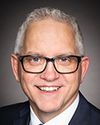Thank you very much, Mr. Chair.
Kwe kwe. Tansi. Unnusakkut. Good morning. Bonjour.
I'm very grateful to be here with you all today on the traditional and unceded territory of the Algonquin Anishinabe people.
Thank you for inviting me to discuss the work the federal government is doing to improve education for indigenous youth.
I know all of you have been working really diligently to understand the history of European settlement and the resulting policies that were meant to displace indigenous people from their lands, traditions and culture, which resulted in many indigenous children, for generations, being robbed of their right to thrive in communities with family and the right to access education comparable to non-indigenous children, often in the same region or territory.
In fact, in 2021, just over 53% of indigenous students graduated from secondary school, and 90% of non-indigenous students in the same year successfully completed their high school education. That gap of 37%, made up of young people with frustrated dreams and paths forward, is a tragedy we all have to work to end.
In 2021, post-secondary education attainment rates for first nations, Inuit and Métis were 45.3%, 33.6% and 56.3%, respectively, while for non-indigenous Canadians it's about 70%. What a waste of talent—talent that Canada needs now more than ever. It should be our collective commitment to make sure we can change these outcomes for this generation and for the next one.
To change those outcomes, we need not just financial investment but strong support for the leaders who are building and rebuilding education systems that are founded on and connected to language and culture from early learning to post-secondary. The mainstream schools have not served indigenous students well, and the effects of racism and a curriculum that whitewashes indigenous perspectives and history have compounded the problem.
Students on reserve must be funded comparably to students in provincial systems off reserve, and investments must be made in critical areas, such as language and culture, full-day kindergarten and before and after school programming.
In 2016, the federal Liberal government began the work of creating new partnerships with indigenous people to reform the way elementary and secondary school education was funded. The government set provincial education formulas as the new minimum base and agreed to modifications that addressed specific first nations' needs and priorities. To bring credibility to this work, the government has increased funding for elementary and secondary education for first nations students on reserve by 74% since 2015.
We see encouraging signs that the new approach is working. As of 2021, just over 53% of first nations youth between the ages of 18-24 had a secondary school diploma or equivalent. That is still too large a gap, but the gap is getting smaller. The deficit left by 10 years of sparse to no new money spent on indigenous youth also meant that infrastructure was often decrepit or unsafe.
Indigenous youth deserve and need safe places to learn. Indigenous Services Canada and the AFN have commissioned studies that demonstrate the unacceptable and shameful gap in infrastructure between indigenous and non-indigenous communities.
Since 2015, the federal government has committed $2.35 billion in targeted funding for school facilities, and $2.27 billion has been allocated, funding 250 projects, including 70 new schools. Of the 250 projects, 164 are now complete, and 86 projects are ongoing. These infrastructure investments serve 270 communities and about 313,000 students. These are very important steps towards closing the infrastructure gap by 2030.
The federal government uses provincial formulas as a minimum base to address the equity gap. Partners have expressed that each regional area is unique, with some communities requiring support for transportation, teacher residences, and/or healthy meals as part of their education systems.
Many indigenous partners are pursuing self-determined education. Nine regional education agreements have been signed to restore control to first nations on the design and delivery of education on reserve, ensuring that learning is grounded in culture and language, and that the funding formulas work best for each unique region.
In July 2022, I had the honour of joining grand chiefs and chiefs of the First Nations Education Council to sign a multi-million dollar regional education agreement with 22 first nations supporting the First Nations Education Council in Quebec.
At that event, I was moved by a young girl who opened the ceremony by speaking in her own indigenous language of Mohawk or Kanienkehaka. She learned her language through an immersion program that she joined in kindergarten.
It was incredibly moving. There are 50 agreements under development, and leaders are determined to provide education that results in confident and capable adults rooted in culture and language.
In January I visited with Dianne Roach, director of operations of the Shingwauk Kinoomaage Gamig, who toured us through the new Anishinabe post-secondary institute partially funded by FedNor. This institute works to preserve the integrity of the Anishinabe language and knowledge. I was greeted by students learning and teaching Ojibwa. The confidence, connection and strength these students are building in themselves is a gift to their communities and to the generations to come.
The promise of reconciliation is that every person in this country has the pride and confidence in themselves that they, too, can reach their full potential. Indeed, our country can thrive only if every first nations, Inuit and Métis child has hope for their future and the confidence that they can learn, grow and contribute to their family, their community, the nation and the world. They must know that they have the best possibility to learn and that they have equal opportunities for education and economic success. This will allow for the promise of a better future, success and prosperity for all of us.
We will get there by ensuring that first nations, Métis and Inuit educators have the tools and resources they need to design and deliver the education that will help their youth succeed.
Thank you, Mr. Chair.





